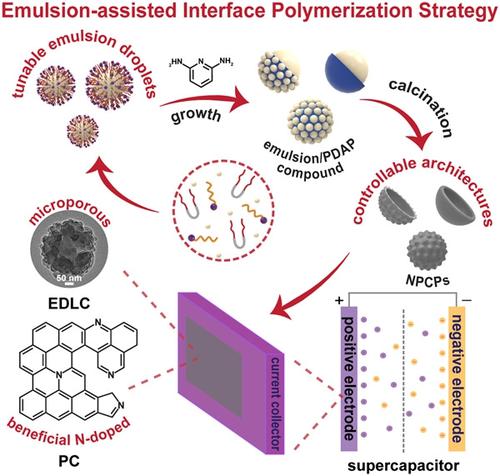当前位置:
X-MOL 学术
›
Battery Energy
›
论文详情
Our official English website, www.x-mol.net, welcomes your
feedback! (Note: you will need to create a separate account there.)
Emulsion-assisted interfacial polymerization strategy: Controllable architectural engineering of anisotropic and isotropic nanoparticles for high-performance supercapacitors
Battery Energy ( IF 9.0 ) Pub Date : 2023-01-06 , DOI: 10.1002/bte2.20220058 Yumeng Liu 1 , Li Li 1 , Liangliang Zhang 1 , Gengxu Han 1 , Zhilin Liu 1 , Jiaxing Huang 1 , Ling Zhang 2 , Jiahuan Luo 3 , Zhu Zhu 4 , Zhen‐An Qiao 1
Battery Energy ( IF 9.0 ) Pub Date : 2023-01-06 , DOI: 10.1002/bte2.20220058 Yumeng Liu 1 , Li Li 1 , Liangliang Zhang 1 , Gengxu Han 1 , Zhilin Liu 1 , Jiaxing Huang 1 , Ling Zhang 2 , Jiahuan Luo 3 , Zhu Zhu 4 , Zhen‐An Qiao 1
Affiliation

|
Anisotropic nanoparticles have attracted extensive attention due to their potential applications in material transport, energy storage, and biopharmaceutical. However, due to the inadequate understanding of microscopic particle formation, controllable asymmetric growth is still a great challenge. Herein, we report a facile emulsion-assisted interfacial polymerization strategy for the synthesis of nitrogen-doped porous carbon particles (NPCPs) with tunable anisotropic/isotropic architectures. During the synthesis process, we can form emulsion droplets with different nanostructures directionally through dual routes, thereby assisting and mediating the polymerization and growth process of the monomer to obtain poly-diaminopyridine nanoparticles with various architectures. The corresponding NPCPs with tunable specific surface area (125–362 m2 g−1), nitrogen content (10%–14%), and diverse morphologies can be acquired by calcination under N2 atmosphere at 700 °C. The synergetic effect of abundant microporous structures and active nitrogen species content contributes to improve the physicochemical properties, while the unique anisotropic architecture increases the charge diffusion efficiency and enhances the high-rate stability. Therefore, the resultant NPCPs electrode exhibits a specific capacitance up to 275 F g−1 at 0.2 A g−1 and surface-area-normalized capacitance of 83.0 μF cm−2, indicating a promising material for high-performance supercapacitors.
中文翻译:

乳液辅助界面聚合策略:用于高性能超级电容器的各向异性和各向同性纳米粒子的可控结构工程
各向异性纳米粒子因其在材料传输、能量存储和生物制药等方面的潜在应用而受到广泛关注。然而,由于对微观粒子形成的认识不足,可控的不对称生长仍然是一个很大的挑战。在此,我们报告了一种简便的乳液辅助界面聚合策略,用于合成具有可调各向异性/各向同性结构的氮掺杂多孔碳颗粒 (NPCP)。在合成过程中,我们可以通过双路定向形成具有不同纳米结构的乳液液滴,从而辅助和调节单体的聚合和生长过程,从而获得具有不同结构的聚二氨基吡啶纳米粒子。具有可调比表面积(125-362 m2 g −1 )、氮含量(10%–14%)和不同的形貌可以通过在N 2气氛下在700 °C下煅烧获得。丰富的微孔结构和活性氮物种含量的协同作用有助于改善物理化学性质,而独特的各向异性结构提高了电荷扩散效率并增强了高倍率稳定性。因此,所得 NPCPs 电极在 0.2 A g -1时表现出高达 275 F g -1 的比电容和 83.0 μF cm -2的表面积归一化电容,表明这是一种很有前途的高性能超级电容器材料。
更新日期:2023-01-06
中文翻译:

乳液辅助界面聚合策略:用于高性能超级电容器的各向异性和各向同性纳米粒子的可控结构工程
各向异性纳米粒子因其在材料传输、能量存储和生物制药等方面的潜在应用而受到广泛关注。然而,由于对微观粒子形成的认识不足,可控的不对称生长仍然是一个很大的挑战。在此,我们报告了一种简便的乳液辅助界面聚合策略,用于合成具有可调各向异性/各向同性结构的氮掺杂多孔碳颗粒 (NPCP)。在合成过程中,我们可以通过双路定向形成具有不同纳米结构的乳液液滴,从而辅助和调节单体的聚合和生长过程,从而获得具有不同结构的聚二氨基吡啶纳米粒子。具有可调比表面积(125-362 m2 g −1 )、氮含量(10%–14%)和不同的形貌可以通过在N 2气氛下在700 °C下煅烧获得。丰富的微孔结构和活性氮物种含量的协同作用有助于改善物理化学性质,而独特的各向异性结构提高了电荷扩散效率并增强了高倍率稳定性。因此,所得 NPCPs 电极在 0.2 A g -1时表现出高达 275 F g -1 的比电容和 83.0 μF cm -2的表面积归一化电容,表明这是一种很有前途的高性能超级电容器材料。





















































 京公网安备 11010802027423号
京公网安备 11010802027423号